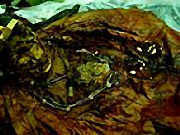
Location: Tongliao, North China's Inner Mongolian Autonomous Region
Period:Liao Dynasty(916-1125)
Excavation period: March 2003
Inner Mongolian Cultural Relics Archeological Research Institute, led by Tala
 Findings
Findings
In March 2003, Chinese archaeologists in northern China's Inner Mongolian Autonomous Region stumbled upon a 1,000-year-old tomb on Tuerji Mountain.
It was confirmed as the tomb belonging to a Khitan aristocrat of the early Liao Dynasty and the second well-preserved large tomb from the Liao found so far in China. The intact skeleton was discovered in the coffin, which was decorated with colorful paintings.
The long slope leading to the tomb gate offers a glimpse inside. The walls along the slope were built with stone blocks painted with frescoes. Most of the colorful murals on the tomb walls, however, have either faded or flaked off. The tomb contains a painted coffin that features red and black hues, with designs of celestial cranes, phoenixes, peonies and propitious clouds. There are bells hanging from the edges of the coffin, whose cover is decorated with three gourd-shaped bronze decoration and phoenix designs engraved along the middle.
The corpse was found wearing 11 layers of silk clothing, with a necklace, headdress, bracelets, rings, earrings, bells around the ankles and a walking stick. The hair was still completely intact.
Researchers brought to light a large number of copper, silver, gold, lacquer and wooden pieces, and silk. Most of the gold and silver ware bore various engravings of animal and human figures.
